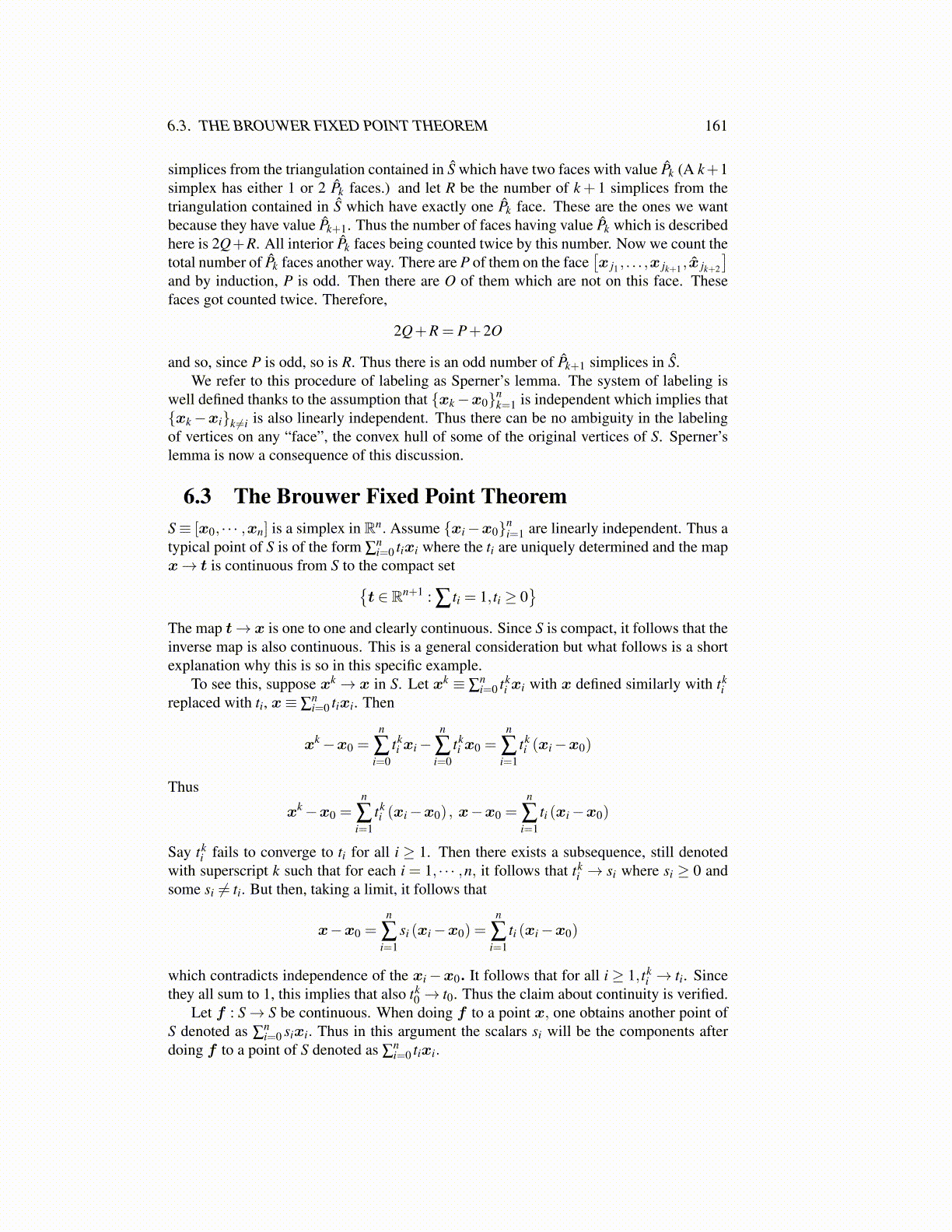
6.3. THE BROUWER FIXED POINT THEOREM 161
simplices from the triangulation contained in Ŝ which have two faces with value P̂k (A k+1simplex has either 1 or 2 P̂k faces.) and let R be the number of k+ 1 simplices from thetriangulation contained in Ŝ which have exactly one P̂k face. These are the ones we wantbecause they have value P̂k+1. Thus the number of faces having value P̂k which is describedhere is 2Q+R. All interior P̂k faces being counted twice by this number. Now we count thetotal number of P̂k faces another way. There are P of them on the face
[x j1 , . . . ,x jk+1 , x̂ jk+2
]and by induction, P is odd. Then there are O of them which are not on this face. Thesefaces got counted twice. Therefore,
2Q+R = P+2O
and so, since P is odd, so is R. Thus there is an odd number of P̂k+1 simplices in Ŝ.We refer to this procedure of labeling as Sperner’s lemma. The system of labeling is
well defined thanks to the assumption that {xk−x0}nk=1 is independent which implies that
{xk−xi}k ̸=i is also linearly independent. Thus there can be no ambiguity in the labelingof vertices on any “face”, the convex hull of some of the original vertices of S. Sperner’slemma is now a consequence of this discussion.
6.3 The Brouwer Fixed Point TheoremS≡ [x0, · · · ,xn] is a simplex in Rn. Assume {xi−x0}n
i=1 are linearly independent. Thus atypical point of S is of the form ∑
ni=0 tixi where the ti are uniquely determined and the map
x→ t is continuous from S to the compact set{t ∈ Rn+1 : ∑ ti = 1, ti ≥ 0
}The map t→ x is one to one and clearly continuous. Since S is compact, it follows that theinverse map is also continuous. This is a general consideration but what follows is a shortexplanation why this is so in this specific example.
To see this, suppose xk → x in S. Let xk ≡ ∑ni=0 tk
i xi with x defined similarly with tki
replaced with ti, x≡ ∑ni=0 tixi. Then
xk−x0 =n
∑i=0
tki xi−
n
∑i=0
tki x0 =
n
∑i=1
tki (xi−x0)
Thus
xk−x0 =n
∑i=1
tki (xi−x0) , x−x0 =
n
∑i=1
ti (xi−x0)
Say tki fails to converge to ti for all i ≥ 1. Then there exists a subsequence, still denoted
with superscript k such that for each i = 1, · · · ,n, it follows that tki → si where si ≥ 0 and
some si ̸= ti. But then, taking a limit, it follows that
x−x0 =n
∑i=1
si (xi−x0) =n
∑i=1
ti (xi−x0)
which contradicts independence of the xi−x0. It follows that for all i ≥ 1, tki → ti. Since
they all sum to 1, this implies that also tk0 → t0. Thus the claim about continuity is verified.
Let f : S→ S be continuous. When doing f to a point x, one obtains another point ofS denoted as ∑
ni=0 sixi. Thus in this argument the scalars si will be the components after
doing f to a point of S denoted as ∑ni=0 tixi.